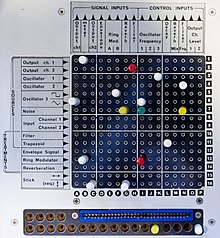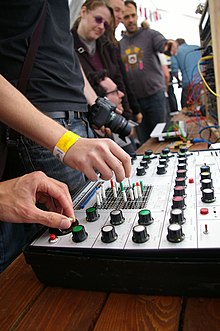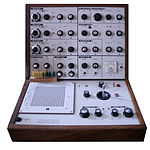EMS VCS 3

Note:it has printed logo: "V.C.S. 3".
TheVCS 3(orVCS3;aninitialismforVoltage Controlled Studio, version #3) is a portableanalog synthesizerwith a flexible modular voice architecture introduced byElectronic Music Studios(EMS) in 1969.[# 1]
EMS released the product under various names. Logos printed at the console's front left (see photos) say "V.C.S. 3"on the most widely sold version;"The Putney (VCS 3)"on the earlier version; and"The Synthi (VCS 3) II"on the later version (Synthi VCS 3 II).[# 2]
History
[edit]The VCS 3 was created in 1969 byPeter Zinovieff'sEMScompany. The electronics were designed largely byDavid Cockerell,and its distinctive appearance was the work of electronic composerTristram Cary.It was one of the firstportablecommercially available synthesizers, in the sense that it was housed entirely in a small wooden case, unlike synths from American manufacturers such asMoog Music,ARPandBuchla,which had large cabinets and could take up entire rooms.
The VCS 3 cost just under £330 in 1969. Some people found it unsatisfactory as a melodic instrument due to its inherent tuning instability.[1]This arose from the instrument's reliance on the then current method of exponential conversion of voltage to oscillator frequency—an approach that other companies also implemented with fewer tuning issues. However, the VCS 3 was renowned as an extremely powerful generator of electronic effects and processor of external sounds for its cost[according to whom?].
The first album recorded using only the VCS 3 wasThe Unusual Classical Synthesizeron Westminster Gold.[2]
The VCS 3 was popular amongprogressive rockbands, and was used on recordings byFranco Battiato,The Moody Blues,The Alan Parsons Project,Jean-Michel Jarre,Todd Rundgren,Hawkwind,Curved Air,Brian Eno(withRoxy Musicand as a solo artist or collaborator),King Crimson,The Who,Gong,andPink Floyd,and many others. The VCS 3-generated bass sound at the beginning of Pink Floyd's "Welcome to the Machine"forms the foundation of the song, with its other parts heard in response. Two VCS 3s and a Sequencer 256 were featured in the 1978 film 'The Shout'.[3]

Description
[edit]The VCS 3 has three oscillators (the first two normalvoltage-controlled oscillators;the third alow-frequency oscillator), anoise generator,two input amplifiers, aring modulator,24 dB/octave low-passvoltage-controlled filter,[citation needed]a trapezoidenvelope generator,a joystick controller, a voltage-controlledspring reverbunit, and two stereo output amplifiers. Unlike mostmodular synthesisersystems, which used cables to link components, the VCS 3 uses a distinctive patchboard matrix where pins are inserted to connect its components.
Keyboards controller
[edit]
connected to VCS 3 (rear)
Although the VCS 3 is often used for generatingsound effectsdue to lack of a built-inkeyboard,external keyboard controllers were available for melodic play. TheDK1,produced in 1969, is an early velocity-sensitive monophonic keyboard for VCS 3 with an extraVCOandVCA.[# 3]In 1972 it was extended forduophonicplay asDK2.[# 4]Also in 1972, theSynthi AKSwas released, as well as a digitalsequencerwith atouch-sensitiveflat keyboard, theKS sequencer,[# 5]and its mechanical keyboard version,DKS.[# 6]
Related models
[edit]The VCS 3's basic design was reused by EMS in many other of their own products,[citation needed]most notably theEMS Synthi 100(1971),[# 7]theSynthi A(1971),[# 8]andAKS(1972, essentially a VCS 3 in a plastic briefcase). The AKS also has asequencerbuilt into the keyboard's lid.[# 9]
A former agent of EMS in theUnited States,Ionic Industries in Morristown, New Jersey, released a portable-keyboard VCS 3 clone in 1973. TheIonic Performer,whose circuitry is based on the VCS 3's, replaced the patchboard matrix with over 100push-buttons,and added a built-in keyboard andeffects units.[4]
-
EMS Synthi AKS(1972)[# 9]
Synthi A
[edit]

TheEMS Synthi Ahas the same electronics as the VCS 3, but was rehoused in a Spartanite briefcase. Instead of routing signals usingpatch cables,likeMoogproducts, it uses apatch matrixwith resistive pins. The 2700 ohm resistors soldered inside each pin vary in tolerance, indicated by different colours: red pins have 1% tolerance, white have 5%, and green pins are attenuating pins with a resistance of 68,000 ohms.
The later Synthi AKS incorporated an early digital 256 event KS (Keyboard Sequencer)sequencerin the lid, with input provided by a capacitance-sensitiveBuchla-style keyboard.
Perhaps its most prominent use is in the introduction toThe Alan Parsons Project'sI Robot.(1977). VCS 3 synthesisers were also used alongside a traditional chamber music ensemble for the soundtrack to the BBC'sLife On Earthnature documentary series, composed byEdward Williams.[5]
Along withKlaus SchulzeandTangerine Dream,other frequent users of the instrument includeCabaret Voltaire,Tim Blake&Miquette GiraudyofGong,Richard PinhasofHeldon,Merzbow,Thomas Lehn,Cor FuhlerandAlva Noto.
Development
[edit]The original VCS No.1 was a hand-built rack-mount unit with two oscillators, one filter and one envelope, designed by Cockerell before the formation of EMS. When a benefactor,Don Banks,asked Zinovieff for a synthesiser, Zinovieff and Cockerell decided to work together on an instrument that was small and portable but powerful and flexible.
Notable users
[edit]- Brian Eno[6]
- Howie BonU2'sPop[7]
- Pink FloydonObscured by Clouds(1972),The Dark Side of the Moon(1973), andWish You Were Here(1975)[8]
- Todd Rundgren
- Pete Townshend
- Jean-Michel Jarre
- Tangerine Dream[9]
- TheBBC Radiophonic Workshop
References
[edit]- ^Reid, Gordon (November 2000)."All About EMS, Part 1".Sound on Sound.Archived fromthe originalon 2016-03-03.
- ^"unusualstuff - krakatack".Sites.google.Retrieved2020-04-12.
- ^"EMS VCS 3" The Shout "1978 | Pin Electronics".
- ^ Dennis Bathory-Kitsz."Killer – My Ionic" Performer "Synth (from Ionic Industories, made by Alfred Mayer)".
- ^Power, Mike. 'Release of Life On Earth soundtrack delivers music as pioneering as the show', inThe Guardian,2 November, 2009
- ^"How Brian Eno Created" Discreet Music "| Reverb Machine".reverbmachine.3 September 2019.Retrieved2022-10-09.
- ^"Flood & Howie B: Producing U2's Pop".Sound On Sound.July 1997. Archived fromthe originalon 2015-06-07.
- ^The, Pink Floyd (1973).The Dark Side Of The Moon(Media notes).:“DAVID GILMOUR Vocals, Guitars, VCS3 / NICK MASON Percussion, Tape Effects / RICHARD WRIGHT Keyboards, Vocals, VCS3 / ROGER WATERS Bass Guitar, Vocals, VCS3, Tape Effects”.
- ^The Cambridge Companion to Krautrock.Cambridge University Press. 27 October 2022.ISBN9781009041591.
Bibliography
[edit]- Hinton, Graham (December 2002)."EMS: The Inside Story".Electronic Music Studios (Cornwall). Archived fromthe originalon 2013-05-21.Retrieved2011-09-30.
- Hinton, Graham (December 2002)."A Guide to the EMS Product Range - 1969 to 1979".Electronic Music Studios (Cornwall). Archived fromthe originalon 2013-10-31.
- Reid, Gordon (November 2000)."All About EMS, Part 1".Sound on Sound.Archived fromthe originalon 2016-03-03.
- Reid, Gordon (December 2000)."All About EMS, Part 2".Sound on Sound.Archived fromthe originalon 2011-09-08.
- Models
- ^ab "VCS3 (aka The Putney) – The Products".Electronic Music Studios (Cornwall). Archived fromthe originalon 2013-10-31.
- ^ "Synthi VCS3 II – The Products".Electronic Music Studios (Cornwall). Archived fromthe originalon 2013-10-31.
- ^ "DK1 (aka The Cricklewood) – The Products".Electronic Music Studios (Cornwall). Archived fromthe originalon 2013-10-31.
- ^ "DK2 – The Products".Electronic Music Studios (Cornwall). Archived fromthe originalon 2013-10-31.
- ^ "KS – The Products".Electronic Music Studios (Cornwall). Archived fromthe originalon 2013-10-31.
- ^ "DKS – The Products".Electronic Music Studios (Cornwall). Archived fromthe originalon 2013-10-31.
- ^ab"Synthi 100 (formerly Digitana, aka the Delaware) – The Products".Electronic Music Studios (Cornwall). Archived fromthe originalon 2013-10-31.Retrieved2011-09-30.
- ^ab "Synthi A (formerly Portabella) – The Products".Electronic Music Studios (Cornwall). Archived fromthe originalon 2013-10-31.
- ^ab "Synthi AKS – The Products".Electronic Music Studios (Cornwall). Archived fromthe originalon 2013-10-31.
Further reading
[edit]- "Retro: VCS3".Future Music.No. 63. Future Publishing. November 1997. p. 55.ISSN0967-0378.OCLC1032779031.
External links
[edit]Official
- http://emssynthesisers.co.uk/
- "An advertisement for the company," every nun needs a Synthi "".Electronic Music Studios (London), Ltd. Archived fromthe originalon 2012-07-17.
- "EMS Home".EMS Rehberg (Germany).
Articles
modification and resources
- Graham Hinton."A Guide to EMS VCS3 & Synthi A/AKS Modifications & Servicing".Hinton Instruments.
- "Information on the EMS synthi A, KS and VCS3".
Software emulation
- "XILS 3, 4 and Vocoder 5000".— A VST simulation of a VCS3/VCS4 with Synthi Sequencer, and Vocoder 5000 by XILS-lab
- "Synthi Avs Plug-In".EMS Rehberg.— A (commercial) VST simulation of a VCS3/Synthi A by EMS Rehberg
- "Cynthia".— A free VST based on the architecture of VCS3/Synthi A by Ninecows
- "iVCS3".— Official EMS iOS emulator by apeSoft, with preface by Peter Zinovieff (screen shot)
EMS Synthi A
- "EMS' homepage (last updated August 1998)".Cornwall: Electronic Music Studios. Archived fromthe originalon 2013-11-25.
- "Every Nun Needs a Synthi"(ad). Archived fromthe originalon 2012-07-17.
- "VCS3 & Synthi A Modifications".Hinton Instruments.(last updated 2013-12-14)
- "Synthi A-VS plugin".Germany: EMS Rehberg.— A commercialVSTsimulation of a Synthi A by German EMS
- A freeware VST simulation of a Synthi A
- The EMS SYNTHI BLOG



![EMS Synthi A (1971), also called Portabella[# 8]](https://upload.wikimedia.org/wikipedia/commons/thumb/d/dc/EMS_A.jpg/120px-EMS_A.jpg)
![EMS Synthi AKS (1972)[# 9]](https://upload.wikimedia.org/wikipedia/commons/thumb/9/96/EMS_Synthi_AKS.jpg/120px-EMS_Synthi_AKS.jpg)
![EMS Synthi 100 (1971), formerly Digitana, also called The Delaware[# 7]](https://upload.wikimedia.org/wikipedia/commons/thumb/e/ec/EMS_Synthi_100.jpg/120px-EMS_Synthi_100.jpg)